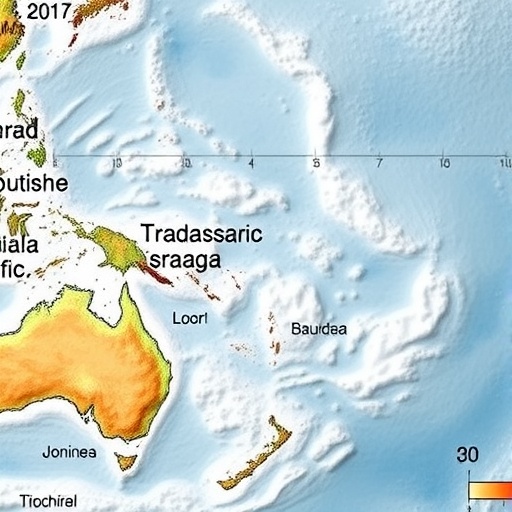A recent study published in Commun Earth Environ sheds light on the profound connection between oceanic variability and the hydroclimate dynamics of the South Pacific basin over millennial timescales. This research, co-authored by leading scientists including M. Peaple, D.T. Skinner, and G.N. Inglis, unearths insights into climatic transformations that have far-reaching implications not only for the region’s environment but potentially for global weather patterns as well. Understanding these changes can help us predict future shifts in climate and their potential impacts on ecosystems and human societies.
The South Pacific region has long been a focal point for climate research, primarily due to its vast oceanic expanse and the role it plays in global climatic systems. Throughout history, variations in ocean temperatures and currents have been closely intertwined with atmospheric conditions. This intricate web of relationships indicates that any shifts in oceanic states can lead to significant alterations in precipitation patterns and temperature distributions across the South Pacific. The authors of this study conducted an extensive analysis of historical climate data, utilizing advanced modeling techniques to reconstruct climatic conditions over the past millennia.
One of the standout observations from the research is the identification of periods where dramatic shifts in hydroclimate can be directly linked to changes in oceanic conditions, such as El Niño and La Niña events. These episodic phenomena are characterized by fluctuating ocean temperatures and currents, which can have cascading effects on weather patterns. The findings suggest that variations in sea surface temperatures and oceanic currents not only influence immediate weather conditions but also contribute to long-term climatic trends that can last for centuries.
In delving into the archives of climate data, the researchers discovered several key epochs characterized by notable transitions in hydroclimate, underscoring the significance of ocean variability. During warmer epochs, higher sea surface temperatures were associated with increased rainfall in certain regions, while prolonged cooler periods resulted in significant droughts. This stark contrast illustrates the sensitivity of hydroclimatic systems to oceanic changes, suggesting that monitoring these variations will be crucial for effective climate prediction.
The implications of such findings are vast. For communities that depend on predictable weather patterns for agriculture and water resources, understanding these ocean-atmosphere interactions is vital. Agricultural productivity and water security in many South Pacific nations hinge on the stability of their climatic conditions. As global temperatures continue to rise due to climate change, the patterns observed in this study may become even more pronounced, leading to heightened challenges for these vulnerable populations.
In addition to the socio-economic ramifications, the researchers emphasize the ecological consequences of these shifts. Altered precipitation patterns can affect freshwater availability, which in turn can impact marine and terrestrial ecosystems. The study points to how species distribution may shift in response to changing water availability, thus disrupting established ecological balances. As marine ecosystems begin to feel the strain of oceanic variability, these changes could initiate a domino effect throughout food chains, affecting biodiversity and the overall health of the ocean.
Moreover, the study expands on the concept of interconnectivity within climatic systems. The researchers highlight that changes in the South Pacific do not occur in isolation. Instead, they interact with broader climatic patterns across the globe. The interconnectedness of various climatic elements means that disruptions in the South Pacific could have ripple effects that extend to distant regions, largely altering weather systems far removed from the initial cause. Recognizing this global dimension of regional climatic changes is imperative for developing comprehensive climate strategies.
The findings from Peaple and colleagues also shed light on the importance of integrating both natural and anthropogenic factors into climate models. While natural ocean variability plays a crucial role, human-induced climate change adds another layer of complexity to these already dynamic systems. Climate models must therefore account for both historical data and future projections, considering the influence of greenhouse gas emissions on oceanic temperatures and weather systems.
Looking forward, the researchers advocate for enhanced monitoring efforts in the South Pacific region. With advanced satellite technology and oceanographic buoys, scientists can gather critical data on ocean temperatures, currents, and other variables that drive climatic shifts. Improved data collection and analysis will provide a clearer picture of how ocean variability influences hydroclimate and will be paramount in developing effective response strategies.
In conclusion, this groundbreaking research underscores the critical need to understand the complex interplay between ocean variability and regional climate dynamics. Awareness of these associations can significantly improve forecasting accuracy and help policymakers devise strategies that mitigate the potential impacts of climate variability on human and ecological systems. Ultimately, insights gained from this study contribute not only to our understanding of the South Pacific but also enhance our global comprehension of climate systems as a whole.
As the scientific community seeks to address the challenges posed by climate change, studies such as this highlight the importance of interdisciplinary approaches that combine climatology, oceanography, and ecological science. By fostering collaboration among these fields, scientists can develop more comprehensive frameworks for understanding climatic behavior and anticipating future changes in our dynamic planet.
Despite the uncertainties inherent in climatic systems, the critical insights garnered from this research provide a vital foundation for future investigations. They pave the way for enhanced predictive capabilities that can inform conservation efforts and sustainability initiatives. As we continue to grapple with the realities of a changing climate, understanding the intricate dance between ocean and atmosphere will be key to safeguarding our environment for generations to come.
Subject of Research: Millennial-scale shifts in South Pacific hydroclimate driven by ocean variability.
Article Title: Ocean variability drives a millennial-scale shift in South Pacific hydroclimate.
Article References:
Peaple, M., Skinner, D.T., Inglis, G.N. et al. Ocean variability drives a millennial-scale shift in South Pacific hydroclimate.
Commun Earth Environ 6, 679 (2025). https://doi.org/10.1038/s43247-025-02676-5
Image Credits: AI Generated
DOI: 10.1038/s43247-025-02676-5
Keywords: Ocean variability, South Pacific, hydroclimate, climate change, El Niño, climate modeling, ecosystems, precipitation patterns, millennial-scale shifts.




